ECU SATURN RELAY 2006 User Guide
[x] Cancel search | Manufacturer: SATURN, Model Year: 2006, Model line: RELAY, Model: SATURN RELAY 2006Pages: 462, PDF Size: 3.06 MB
Page 60 of 462

Top Tether Anchor
A top tether (A, C) anchors the top of the child restraint
to the vehicle. A top tether anchor is built into the
vehicle. The top tether attachment (B) on the child
restraint connects to the top tether anchor in the vehicle
in order to reduce the forward movement and rotation
of the child restraint during driving or in a crash.Your child restraint may have a single tether (A) or a
dual tether (C). Either will have a single attachment (B)
to secure the top tether to the anchor.
Some top tether-equipped child restraints are designed
for use with or without the top tether being attached.
Others require the top tether always to be attached. In
Canada, the law requires that forward-facing child
restraints have a top tether, and that the tether be
attached. In the United States, some child restraints also
have a top tether. Be sure to read and follow the
instructions for your child restraint.
If the child restraint does not have a top tether, one can
be obtained, in kit form, for many child restraints. Ask
the child restraint manufacturer whether or not a kit
is available.
1-54
ProCarManuals.com
Page 62 of 462
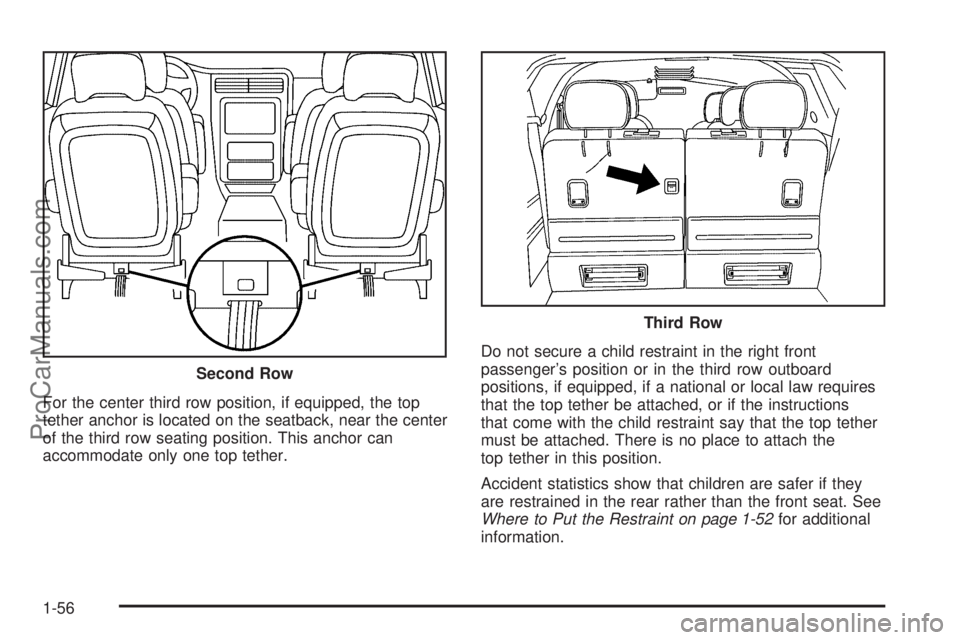
For the center third row position, if equipped, the top
tether anchor is located on the seatback, near the center
of the third row seating position. This anchor can
accommodate only one top tether.Do not secure a child restraint in the right front
passenger’s position or in the third row outboard
positions, if equipped, if a national or local law requires
that the top tether be attached, or if the instructions
that come with the child restraint say that the top tether
must be attached. There is no place to attach the
top tether in this position.
Accident statistics show that children are safer if they
are restrained in the rear rather than the front seat. See
Where to Put the Restraint on page 1-52for additional
information. Second Row
Third Row
1-56
ProCarManuals.com
Page 63 of 462
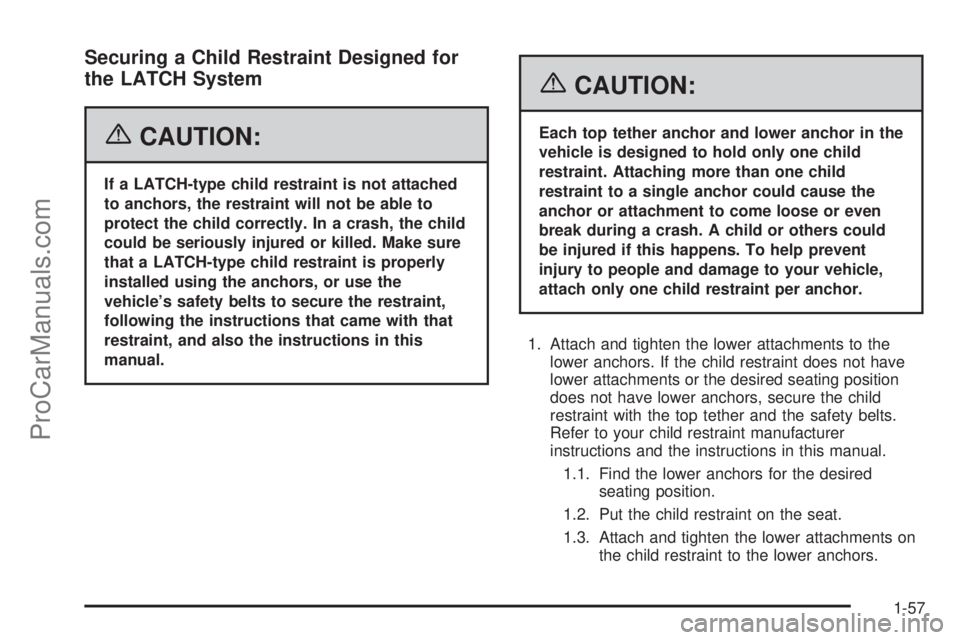
Securing a Child Restraint Designed for
the LATCH System
{CAUTION:
If a LATCH-type child restraint is not attached
to anchors, the restraint will not be able to
protect the child correctly. In a crash, the child
could be seriously injured or killed. Make sure
that a LATCH-type child restraint is properly
installed using the anchors, or use the
vehicle’s safety belts to secure the restraint,
following the instructions that came with that
restraint, and also the instructions in this
manual.
{CAUTION:
Each top tether anchor and lower anchor in the
vehicle is designed to hold only one child
restraint. Attaching more than one child
restraint to a single anchor could cause the
anchor or attachment to come loose or even
break during a crash. A child or others could
be injured if this happens. To help prevent
injury to people and damage to your vehicle,
attach only one child restraint per anchor.
1. Attach and tighten the lower attachments to the
lower anchors. If the child restraint does not have
lower attachments or the desired seating position
does not have lower anchors, secure the child
restraint with the top tether and the safety belts.
Refer to your child restraint manufacturer
instructions and the instructions in this manual.
1.1. Find the lower anchors for the desired
seating position.
1.2. Put the child restraint on the seat.
1.3. Attach and tighten the lower attachments on
the child restraint to the lower anchors.
1-57
ProCarManuals.com
Page 64 of 462
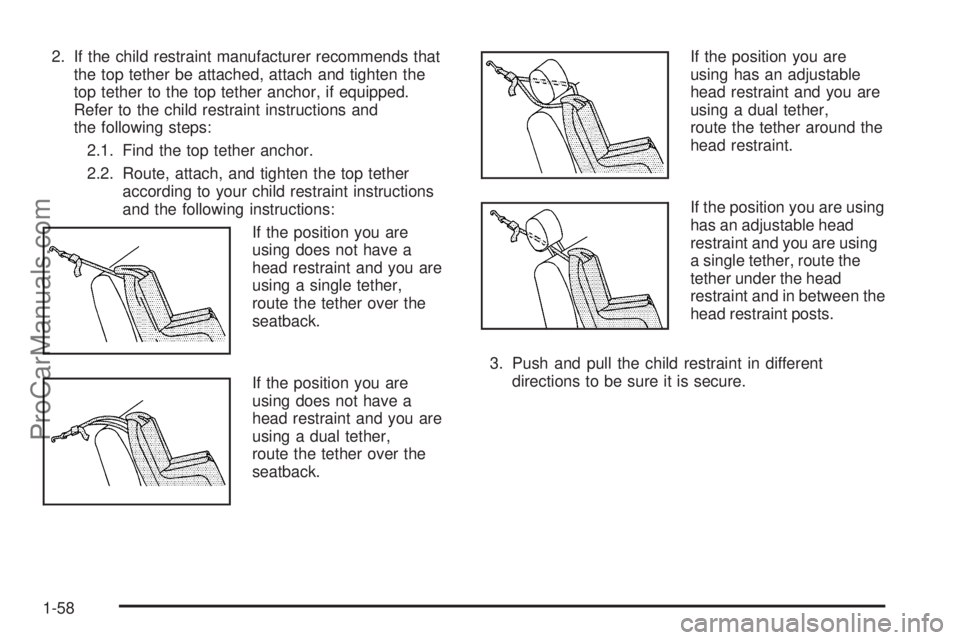
2. If the child restraint manufacturer recommends that
the top tether be attached, attach and tighten the
top tether to the top tether anchor, if equipped.
Refer to the child restraint instructions and
the following steps:
2.1. Find the top tether anchor.
2.2. Route, attach, and tighten the top tether
according to your child restraint instructions
and the following instructions:
If the position you are
using does not have a
head restraint and you are
using a single tether,
route the tether over the
seatback.
If the position you are
using does not have a
head restraint and you are
using a dual tether,
route the tether over the
seatback.If the position you are
using has an adjustable
head restraint and you are
using a dual tether,
route the tether around the
head restraint.
If the position you are using
has an adjustable head
restraint and you are using
a single tether, route the
tether under the head
restraint and in between the
head restraint posts.
3. Push and pull the child restraint in different
directions to be sure it is secure.
1-58
ProCarManuals.com
Page 65 of 462
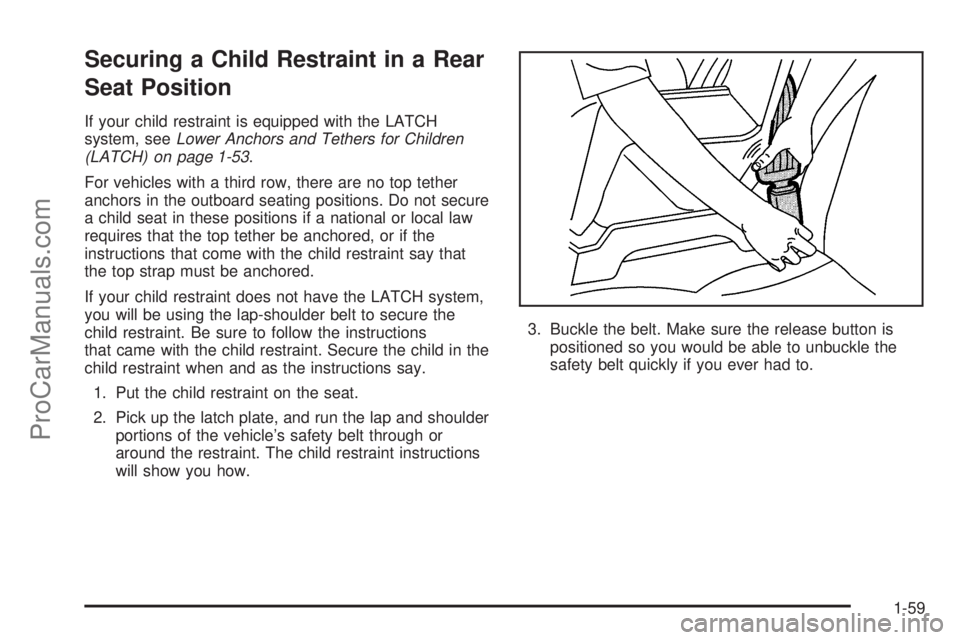
Securing a Child Restraint in a Rear
Seat Position
If your child restraint is equipped with the LATCH
system, seeLower Anchors and Tethers for Children
(LATCH) on page 1-53.
For vehicles with a third row, there are no top tether
anchors in the outboard seating positions. Do not secure
a child seat in these positions if a national or local law
requires that the top tether be anchored, or if the
instructions that come with the child restraint say that
the top strap must be anchored.
If your child restraint does not have the LATCH system,
you will be using the lap-shoulder belt to secure the
child restraint. Be sure to follow the instructions
that came with the child restraint. Secure the child in the
child restraint when and as the instructions say.
1. Put the child restraint on the seat.
2. Pick up the latch plate, and run the lap and shoulder
portions of the vehicle’s safety belt through or
around the restraint. The child restraint instructions
will show you how.3. Buckle the belt. Make sure the release button is
positioned so you would be able to unbuckle the
safety belt quickly if you ever had to.
1-59
ProCarManuals.com
Page 67 of 462
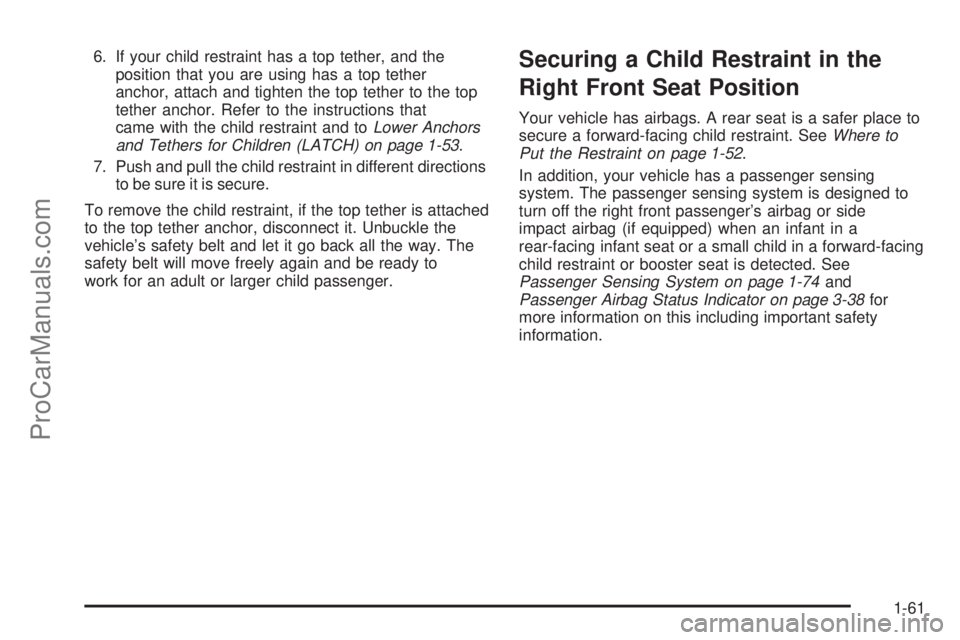
6. If your child restraint has a top tether, and the
position that you are using has a top tether
anchor, attach and tighten the top tether to the top
tether anchor. Refer to the instructions that
came with the child restraint and toLower Anchors
and Tethers for Children (LATCH) on page 1-53.
7. Push and pull the child restraint in different directions
to be sure it is secure.
To remove the child restraint, if the top tether is attached
to the top tether anchor, disconnect it. Unbuckle the
vehicle’s safety belt and let it go back all the way. The
safety belt will move freely again and be ready to
work for an adult or larger child passenger.Securing a Child Restraint in the
Right Front Seat Position
Your vehicle has airbags. A rear seat is a safer place to
secure a forward-facing child restraint. SeeWhere to
Put the Restraint on page 1-52.
In addition, your vehicle has a passenger sensing
system. The passenger sensing system is designed to
turn off the right front passenger’s airbag or side
impact airbag (if equipped) when an infant in a
rear-facing infant seat or a small child in a forward-facing
child restraint or booster seat is detected. See
Passenger Sensing System on page 1-74and
Passenger Airbag Status Indicator on page 3-38for
more information on this including important safety
information.
1-61
ProCarManuals.com
Page 68 of 462

A label on your sun visor says, “Never put a rear-facing
child seat in the front.” This is because the risk to the
rear-facing child is so great, if the airbag deploys.
{CAUTION:
A child in a rear-facing child restraint can be
seriously injured or killed if the right front
passenger’s airbag in�ates. This is because
the back of the rear-facing child restraint
would be very close to the in�ating airbag.
Even though the passenger sensing system is
designed to turn off the passenger’s frontal
airbag and seat-mounted side impact airbag (if
equipped) under certain conditions, no system
is fail-safe, and no one can guarantee that an
airbag will not deploy under some unusual
circumstance, even though it is turned off.
General Motors recommends that rear-facing
child restraints be secured in the rear seat,
even if the airbag is off.If you need to secure a forward-facing child restraint in
the right front seat position, move the seat as far back as
it will go before securing the forward-facing child restraint.
SeeManual Seats on page 1-2orSix-Way Power Seats
on page 1-3.
If your child restraint is equipped with the LATCH system,
seeLower Anchors and Tethers for Children (LATCH) on
page 1-53.
There is no top tether anchor at the right front seating
position. Do not secure a child seat in this position if a
national or local law requires that the top tether be
anchored or if the instructions that come with the child
restraint say that the top tether must be anchored. See
Lower Anchors and Tethers for Children (LATCH) on
page 1-53if the child restraint has a top tether.
1-62
ProCarManuals.com
Page 69 of 462

You will be using the lap-shoulder belt to secure the child
restraint in this position. Be sure to follow the instructions
that came with the child restraint. Secure the child in the
child restraint when and as the instructions say.
1. Your vehicle has a right front passenger’s airbag.
SeePassenger Sensing System on page 1-74.
General Motors recommends that rear-facing child
restraints be secured in a rear seat, even if the
airbag or airbags are off. If your child restraint is
forward-facing, move the seat as far back as it will go
before securing the child restraint in this seat. See
Manual Seats on page 1-2orSix-Way Power Seats
on page 1-3.
When the passenger sensing system has turned off
the right front passenger’s airbag or airbags, the
off indicator in the passenger airbag status indicator
should light and stay lit when you turn the ignition
to RUN or START. SeePassenger Airbag
Status Indicator on page 3-38.
2. Put the child restraint on the seat.
3. Pick up the latch plate, and run the lap and shoulder
portions of the vehicle’s safety belt through or
around the restraint. The child restraint instructions
will show you how.4. Buckle the belt. Make sure the release button is
positioned so you would be able to unbuckle the
safety belt quickly if you ever had to.
1-63
ProCarManuals.com
Page 70 of 462

5. Pull the rest of the shoulder belt all the way out of
the retractor to set the lock.6. To tighten the belt, push down on the child restraint,
pull the shoulder portion of the belt to tighten the lap
portion of the belt and feed the shoulder belt back
into the retractor. If you are using a forward-facing
child restraint, you may �nd it helpful to use your
knee to push down on the child restraint as you
tighten the belt. You should not be able to pull
more of the belt from the retractor once the lock
has been set.
7. Push and pull the child restraint in different
directions to be sure it is secure.
8. If the airbag or airbags are off, the off indicator on
the instrument panel will be lit and stay lit when the
key is turned to RUN or START.
1-64
ProCarManuals.com
Page 71 of 462

If a child restraint has been installed and the on
indicator is lit, turn the vehicle off. Remove the child
restraint from the vehicle and reinstall the child restraint.
If after reinstalling the child restraint and restarting
the vehicle, the on indicator is still lit, check to make
sure that the vehicle’s seatback is not pressing the child
restraint into the seat cushion. If this happens, slightly
recline the vehicle’s seatback and adjust the seat
cushion if possible. Also make sure the child restraint is
not trapped under the vehicle head restraint. If this
happens, adjust the head restraint.
If the on indicator is still lit, secure the child in the child
restraint in a rear seat position in the vehicle and
check with your retailer.
To remove the child restraint, just unbuckle the vehicle’s
safety belt and let it go back all the way. The safety
belt will move freely again and be ready to work for an
adult or larger child passenger.Airbag System
Your vehicle has a frontal airbag for the driver and a
frontal airbag for the right front passenger. Your vehicle
may also have side impact airbags. Side impact
airbags are available for the driver, the right front
passenger and the second row captain’s chairs (if
equipped).
If your vehicle has a side impact airbag, the words
AIRBAG will appear on the airbag covering on the side
of the seatback closest to the door.
Frontal airbags are designed to help reduce the risk of
injury from the force of an in�ating frontal airbag.
But these airbags must in�ate very quickly to do their
job and comply with federal regulations.
1-65
ProCarManuals.com